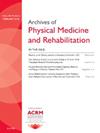Opioid and Benzodiazepine Use Among a Population-Based Cohort of Adults With Chronic Spinal Cord Injury: Correspondence Between Self-report and State Prescription Monitoring Data
IF 3.7
2区 医学
Q1 REHABILITATION
Archives of physical medicine and rehabilitation
Pub Date : 2025-10-01
DOI:10.1016/j.apmr.2025.04.017
引用次数: 0
Abstract
Objective
To compare self-reported opioid and benzodiazepine use to rates of prescriptions dispensed among persons with chronic spinal cord injury (SCI), to evaluate the extent of potential underreporting.
Design
Cross-sectional self-report assessment (SRA) and retrospective review of prescription monitoring program (PMP) data.
Setting
Community dwelling adults in the Southeastern United States.
Participants
In total, 345 adults (N=345) (>18y) with chronic (>1y) SCI who were identified through a state population-based SCI registry and who responded to SRA opioid use questions in a parent study.
Interventions
Not applicable.
Main Outcome Measures
Self-reported prescription pain reliever, sedative, and tranquilizer use, and prescriptions dispensed based on PMP data. We compared self-reported past year utilization with records of dispensed prescriptions to assess potential underreporting, defined as reporting “never” using either opioids (pain relievers) or benzodiazepines (sedatives/tranquilizers) in the past year, but having had 2 or more respective prescriptions dispensed in the year before the SRA.
Results
Among the 345 participants who responded to the opioid use questions, we were able to match 252 to the PMP; reasons for not matching include not filling a controlled substance prescription in-state, either because of lack of reportable prescriptions or the prescription was dispensed out of state. Evaluating each prescription medication, rates of underreporting for each drug ranged from 0.4% to 4% for hydrocodone, oxycodone, tramadol, codeine, buprenorphine, and hydromorphone. There was 100% agreement in the self-reported use and dispensed records for fentanyl, oxymorphone, meperidine, and methadone. The rates of potential underreporting of benzodiazepines were <2%. Overall, of the 252 matched individuals, 11% underreported opioids (2 or more prescriptions dispensed) and 1% underreported benzodiazepines.
Conclusions
The findings suggest considerable agreement between self-reported and dispensed prescription medication use, and only minimal potential underreporting of select opioids and benzodiazepines, confirming the appropriateness of self-report of these prescription medications with people with SCI.
阿片类药物和苯二氮卓类药物在慢性脊髓损伤成人人群队列中的使用:自我报告与国家处方监测数据之间的对应关系
目的:比较慢性脊髓损伤(SCI)患者自我报告的阿片类药物和苯二氮卓类药物的使用与处方分配率,以评估潜在的低报程度。设计:横断面自我报告评估(SRA)和处方监测程序(PMP)数据的回顾性审查。环境:美国东南部社区居住的成年人(US)。参与者:345名慢性(> - 1年)脊髓损伤成人(> - 18岁),通过国家基于人群的脊髓损伤登记处确定,并在家长研究中回答SRA阿片类药物使用问题。干预措施:不适用主要结局测量:自我报告的处方止痛药、镇静剂和镇静剂的使用,以及基于PMP数据分配的处方。我们将自我报告的过去一年的使用情况与分配的处方记录进行比较,以评估潜在的漏报,漏报的定义是报告“从未”使用阿片类药物(止痛药)或苯二氮卓类药物(镇静剂/镇静剂),但在SRA前一年有两种或两种以上的处方。结果:在回答阿片类药物使用问题的345名参与者中,我们能够将252名与PMP相匹配;不匹配的原因包括没有在州内填写受控物质处方,要么是由于缺乏可报告的处方,要么是处方在州外分发。对每种处方药进行评估后发现,氢可酮、羟考酮、曲马多、可待因、丁丙诺啡和氢吗啡酮的少报率在0.4% - 4%之间。芬太尼、羟吗啡酮、哌嗪和美沙酮的自我报告使用和分配记录100%一致。苯二氮卓类药物潜在漏报率低于2%。总的来说,在252名匹配的个体中,11%的人少报了阿片类药物(分发了2个或更多处方),1%的人少报了苯二氮卓类药物。结论:研究结果表明,自我报告和配发的处方药使用情况之间存在相当大的一致性,并且选择性阿片类药物和苯二氮卓类药物的潜在漏报极小,证实了SCI患者自我报告这些处方药的适当性。
本文章由计算机程序翻译,如有差异,请以英文原文为准。
求助全文
约1分钟内获得全文
求助全文
来源期刊
CiteScore
6.20
自引率
4.70%
发文量
495
审稿时长
38 days
期刊介绍:
The Archives of Physical Medicine and Rehabilitation publishes original, peer-reviewed research and clinical reports on important trends and developments in physical medicine and rehabilitation and related fields. This international journal brings researchers and clinicians authoritative information on the therapeutic utilization of physical, behavioral and pharmaceutical agents in providing comprehensive care for individuals with chronic illness and disabilities.
Archives began publication in 1920, publishes monthly, and is the official journal of the American Congress of Rehabilitation Medicine. Its papers are cited more often than any other rehabilitation journal.

 求助内容:
求助内容: 应助结果提醒方式:
应助结果提醒方式:


